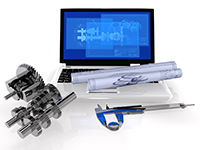 Computer-aided and “model-driven” product development practices have steadily evolved since the 1960s, enabled by the growth and availability of modern computing technology. Companies use software to create digitalized 2D/3D geometry and assess that geometry using physics-based performance calculations. The industry has rapidly progressed from tools built for and used exclusively on the engineer’s desktop in discrete domains such as design (CAD), simulation (CAE), test & evaluation (CAT), manufacturing (CAM) and requirements management to more enterprise oriented and internet-enabled solutions such as product data management (PDM), product lifecycle management (PLM), software lifecycle management (ALM), and service lifecycle management (SLM).
Computer-aided and “model-driven” product development practices have steadily evolved since the 1960s, enabled by the growth and availability of modern computing technology. Companies use software to create digitalized 2D/3D geometry and assess that geometry using physics-based performance calculations. The industry has rapidly progressed from tools built for and used exclusively on the engineer’s desktop in discrete domains such as design (CAD), simulation (CAE), test & evaluation (CAT), manufacturing (CAM) and requirements management to more enterprise oriented and internet-enabled solutions such as product data management (PDM), product lifecycle management (PLM), software lifecycle management (ALM), and service lifecycle management (SLM).
The fundamental business premise and goals for implementing these model-based technologies and processes is that they will enable on-going product and manufacturing innovation to create competitive advantage, minimize total lifecycle costs, and drive top line revenue growth. While there has been considerable business success within selected industry segments and application domains, the complexity of products and systems is increasing exponentially due to more software and electronics content. Game changing new product development technologies such as, additive manufacturing (3D printing), the Internet of Things/Industry 4.0, and “design-to-purpose” materials, will require new approaches to product development. There is now an imperative to engage and collaborate across diverse engineering domains to develop better “systems-oriented” solutions and conduct a much greater amount of “virtual” experimentation early in the product development process to gain insights into key product attributes and performance parameters.
As such, significant challenges still exist in realizing the “Digital Thread” vision: product development processes, data and engineering knowledge that are connected and traceable throughout the entire product lifecycle. And the more traditional product lifecycle focus must now also embrace the new challenges and opportunities presented by the advent of the Internet of Things and Industry 4.0 and the advent of billions of “digital twins” interacting via the internet.
To learn more about the differences and overlap of current different model-based viewpoints and discuss the challenges, emerging standards, and business opportunities in achieving the "digital thread” vision join us for one of our global PLM Market & Industry Forum events.
Don
